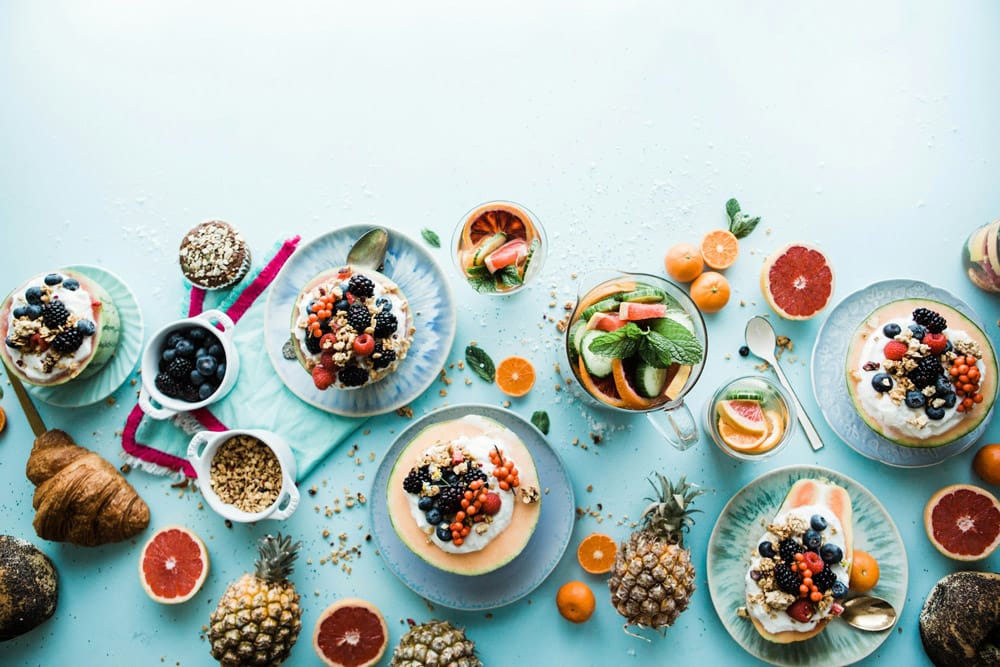How to Build Healthy Eating Habits Without Feeling Restricted

Healthy eating requires more than basic salad and water. A well-balanced diet requires diversified food choices and equal portions without any food restrictions. Eating a diet rich in vegetables, fruits, and whole grains with lean proteins decreases risks for obesity together with diabetes and heart disease among other chronic illnesses.
Experts recommend eating nutrition-dense whole foods instead of processed products: fruits together with vegetables (you should consume five servings daily), legumes, nuts and whole grains form a healthy foundation. You can eat foods you love but only as small quantities (we’ll discuss that later). Your body and energy need proper nourishment instead of rigorous food rule systems for punishment.
Healthy Eating Basics
- Choose whole, nutrient-dense foods
- Include fruits, vegetables, legumes, nuts, and whole grains
- Enjoy favorite foods in small, intentional amounts
- Avoid rigid “good vs bad” food thinking
Start With Smart Grocery Shopping
Healthy habits start in the kitchen and at the store. Plan your meals and grocery trips ahead of time. Spending time during meals planning your food choices and grocery shopping list develops a more organized approach. Set aside one specific day each week to plan your simple meals and create your shopping list.
Pre-planned shopping lists stop you from roaming the store and grabbing unexpected food products from your basket. You should write down meals which include proteins (chicken or beans and tofu), a broad variety of vegetables, whole grains, as well as fruits then stay dedicated to this plan.
Stay on the store perimeter since foods like fresh produce and dairy products and fresh meats are sorted along the edges. This method helps you pick fresh foods before anything else. Finally, read nutrition labels: check serving sizes and ingredients to spot hidden sugar, salt, or trans fats. These simple steps keep your cart full of nutritious staples instead of ultra-processed snacks.
Smart Grocery Shopping Tips
- Stick to a pre-planned list
- Shop the store’s outer aisles
- Prioritize fresh produce, lean proteins, and whole grains
- Read nutrition labels for added sugars, fats, and salt
Balanced Meal Ideas
Plan ahead at the grocery store. Get ready to grocery shop with a list or just take a fast snapshot of your refrigerator contents. Fresh produce together with healthy proteins can be found along the store boundaries. Read labels with attention to detail because sugar content and fat content data for each serving will help you stay away from surreptitious additives.
Beyond shopping, simple meal ideas can make healthy eating easy. Focus your meals on balanced portions where you fill half your plate with veggies followed by 25% lean protein from fish or chicken or beans or eggs and the remaining 25% whole grains including brown rice and oats and whole-wheat bread.
Your meal options at breakfast can include whole-grain cereal or oatmeal with berries, lunchtime features turkey or veggie sandwich on whole-grain bread with a salad side while evening meals consist of grilled salmon (or tofu) with roasted vegetables and quinoa. Snacks are allowed when they consist of fruit and yogurt and nuts or hummus served alongside vegetables remain good choices for healthy munching. Meal prepping is beneficial as it can save time and you don’t have to worry what to cook for next meal.
Balanced Meal Ideas
- Breakfast: Oatmeal + fruit + nuts
- Lunch: Whole grain sandwich + salad
- Dinner: Grilled fish or tofu + veggies + whole grains
- Snacks: Yogurt + fruit, or hummus + raw veggies
Over time small lifestyle changes combine to create major transformation: The World Health Organization (WHO) states that eating fruits and vegetables with beans and nuts and whole grains on a regular basis decreases health complications while promoting nutritional balance in your diet.
Establish a Helpful Eating Routine
Think about developing “healthy habits” instead of looking at weight loss as a goal. Studies show that people who lose weight successfully don’t just follow short-term fad plans, they make lasting changes to their eating patterns.
Simple nutrition substitutions like eating a piece of fruit instead of a donut and baked chicken instead of fried items, these simple replacements eventually become your new normal. Strategy-driven weight loss at a rate of approximately 1–2 pounds every week has safety benefits and remains maintainable.
Managing a modest bodyweight loss of 5–10% yields positive health outcomes such as better blood sugar regulation and improved blood pressure and better cholesterol levels.
Focus on nutrient-rich foods to feel full on fewer calories. Your diet should include fresh vegetables in combination with fruits and whole grains and low-fat dairy products. Plan every meal to contain lean protein sources such as chicken or fish or beans or tofu since these foods promote satiety.
A valuable eating strategy involves establishing set mealtimes so you never find yourself starving between your regular meals. For instance, eat every 3–4 hours, a balanced breakfast, lunch, dinner, plus a couple of healthy snacks (like yogurt with fruit or carrots with hummus) helps keep energy steady and prevents bingeing when you’re famished.
Helpful Eating Routine
- Eat every 3–4 hours
- Include lean proteins at each meal
- Have healthy snacks on hand
- Prevent extreme hunger to avoid overeating
Also Read: Why Meal Timing Might Matter More Than You Think for TDEE Optimization
Track for Success
A substantiated eating tip involves keeping track of what you eat. Research demonstrates twice the weight loss success rate for food journal users or tracking app users when compared to people who don't use tracking methods. Track your meals in a notebook or an app while noting portion sizes and your emotional state during meals.
Reviewing your logs afterward helps identify potential adjustments while helping you keep track of your actions. (TIP: Before you start tracking, write down your main goals, weight loss, lower sugar, etc., so you remember why you’re doing this.)
Track for Success
- Use a food journal or app
- Log portion sizes and hunger levels
- Write down your goals
- Review your patterns weekly
Developing a Positive Mental Relationship with Food
Healthy eating isn’t just about what you eat, but how you think about it. Diet culture divides food into either “good” or “bad” categories causing users to experience guilt and anxiety.
A mindful solution is recommended by professionals over food judgmental approach. Mindful eating requires you to pay close attention to your body's signals of fullness and hunger while savoring bites and listening to your body's messages. When you eat more slowly you may sense flavors and experience food textures better so you feel happy with smaller meal portions.
Crucially, remove guilt. Food is neither ‘good’ nor ‘bad’. Maintain a neutral perspective toward food and focus on body benefits. Replace your self-talk with more positive expressions by stating “I choose not to have it right now” instead of “I can’t have dessert”.
Your subtle change in eating control gives you back the power over your diet and eliminates the limited feeling you might experience. Mindful eating professionals describe the experience of giving yourself tiny amounts of preferred foods as incredibly liberating. Through mindful texture appreciation a single chocolate piece satisfies me.
Mindful Eating Reminders
- No food is “bad”
- Savor your food slowly
- Focus on how food makes you feel
- Use positive self-talk (“I choose…” not “I can’t…”)
Practical Mindfulness Tips
- Sit down and focus: Eat without distractions like TV or phones. Give your food your full attention, chewing well and noticing flavors.
- Check in with hunger: Before you eat, ask if you are truly hungry or if you’re just bored or stressed. Eat when you feel a moderate hunger, and stop when you feel comfortably full.
- Plan for all foods: Mentally plan your meals (including any treats) ahead of time. Knowing you’ll have an ice-cream cone or cookie on the weekend can make it easier to enjoy meals during the week without feeling deprived.
- Be kind to yourself: If you slip up or overeat, don’t dwell on it. Healthy eating is a journey. Experts say mindfulness is “non-shaming”, replace any “should” or “have to” thoughts with curiosity and kindness.
Build a Positive Mindset
- Daily food plan: Write out or mentally list main meals + treats
- Scheduled treats: Allow regular small treats as planned treats
- Portion awareness: Use smaller plates, pre-portion snacks
- Gratitude: Take a moment to appreciate your food before eating
Also Read: Macros or Calories: What’s More Important for Fat Loss?
Final Tips for Sustainable Change
Transformation into healthy eating habits requires time. Celebrate minor wins such as picking an additional vegetable for your plate or skipping a vending machine snack while you learn from failures. The formation of habits needs time: making a change for 21 days or more can turn it into an automatic behavior. Use a journal or app to keep track of your meals and moods and progress then share your goals with friends or groups for accountability assistance.
Give yourself adequate time and treat yourself gently. Changes in eating patterns should never become a method of punishment. By focusing on nutritious, enjoyable foods most of the time, preparing meals in advance, and listening to your body, you’ll naturally build a sustainable healthy routine. These habits will become automatic over time so eating well feels natural rather than limited.



